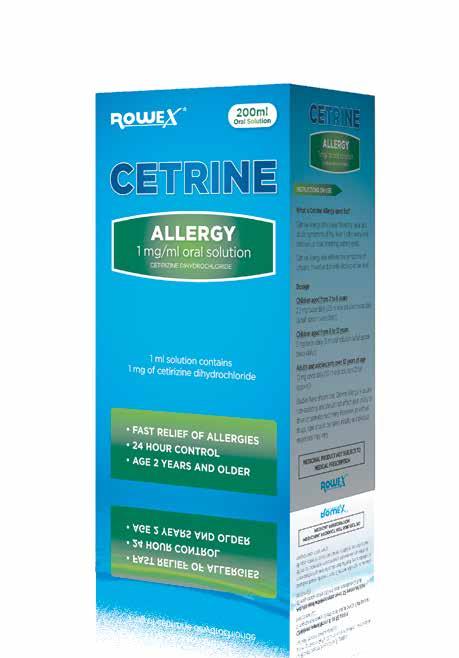
14 minute read
CATEGORY REPORT: FOCUS ON ALLERGIES
Focus Allergies
The Prevalence of Allergies
Allergy is the most common chronic disease in Europe (EAACI, 2015) and Ireland has some of the highest prevalence rates of allergic conditions in the world.

In LloydsPharmacy, sales of medicines for allergies have increased by 10% in the past 2 years. We experienced 35% growth in this category in the summer of 2021 and in 2022 we are trending at a similar level to last summer.
The allergies sector is therefore a key focus within Pharmacy to ensure Pharmacy teams can offer their patients the right knowledge, products and advice to help manage symptoms and improve their quality of life.
Allergy Age Profile
Allergic rhinitis (AR) in the paediatric population is quite high, making it one of the most common chronic paediatric disorders (Akhouri SA, 2020).) The percentage of children diagnosed with allergic rhinitis and eczema have both trebled over the last 30 years (Gupta R, 2007). Allergic rhinitis affects between 10% and 30% of all adults and as many as 40% of children (Pawankar et al., 2013) Allergic conjunctivitis symptoms are present in up to 71% of patients with allergic rhinitis. (Leonardi et al., 2015) Oral Allergy Syndrome affects almost 46% of Seasonal Allergic Rhinitis sufferers causing itching, tingling, and swelling of lips, tongue, palate and pharynx (IviČeviĆ et al., 2015.
Most common allergens
Almost half (48%) of sufferers have more than one allergy (Mintel, 2010) • House dust mites - In a
European study House Dust
Mite (HDM) sensitivity was seen 22% of the study population. • Grass and tree pollens - In a
Survey 21% of allergy sufferers had Hay fever (2018 omnibus 1000x people in Ireland) • Pet hair or skin flakes - Allergies to dogs and cats affect 10%-20% of the population worldwide and is a growing public health concern as these rates increase (Chan S, 2018) • Fungal or mould spores • Food (particularly milk, eggs, wheat, soya, seafood, fruit and nuts) • Wasp and bee stings • Certain medications, such as penicillin and aspirin • Latex
• Household chemicals
Written by Martin Hynes, Clinical Governance Pharmacist, LloydsPharmacy
Symptoms and Impact on Quality of Life
Research conducted on behalf of LloydsPharmacy by Empathy research with 1000 adults over 18 years old outlined most common symptoms include 76% sneezing, Runny/Blocked nose 72%, Itchy/ watery eyes 71% Patients with allergies report their symptoms as causing significant daily disruptions to their lives (Canonica et al., 2008): • 36% experienced puffy eye lids • 74 % experienced itchy, watery and burning eyes • 36% experienced a blocked nose
• 70% experienced either a blocked nose, a runny nose or sneezing • 34% experienced fatigue • 36% experienced an itchy palate
Everyday activities impacted by allergies
• Sleep disturbance and impact on general mood • Socialising and especially outdoors during pollen season (April to September) • Travel plans • Ability to concentrate for tasks such as reading or reading screens at work
• Ability to exercise outdoors during pollen season • Sick days from work
How Pharmacy staff can help Patients
Community pharmacists are most often the first port of call for patients with allergy symptoms. Friendly pharmacy colleagues and pharmacists who take the time to engage with the patients, offer some useful practical tips and recommend suitable products to meet their needs can make a real difference to the patient’s quality of life.
A simple WWHAM interview will reveal the patient’s symptoms and the products that they may have tried already as well as any existing medical conditions and current medication. This will allow the pharmacy colleagues to recommend products that will best meet the needs of the patient. Taking the time to listen to the patient’s past experiences and what products they have previously tried is particularly important. 67% are dissatisfied with current treatment options for allergy. (Werkhauser et al.,2015) and around 40% of patients per hayfever season will switch medications in an effort to find effective relief. (IPN,2020). Some patients may prefer oral medication while others may prefer topical treatments e.g., some of the antihistamines used to treat allergic rhinitis, may produce sedation and for practical reasons, people will wish to avoid such products for daytime use. Other ways of supporting this patient group and alerting them to the available supports are via: • Instore information leaflets, • Advice and practical tips on digital screens (symptoms and treatment) • Point of Sale displays Pharmacists will also exercise their professional judgement and will know if the patient needs to be referred to their GP. For example, if a patient with asthma is experiencing shortness of breath, if an allergy rash is particularly aggressive or if the patient has tried multiple products already without any success in achieving relief from their symptoms.
Treatments
• Oral antihistamines are core to the range, across a choice of brands. However, in recent years there has been an increase in choice of nasal and eye products as patients often require more than one treatment. • New product development from drug free natural remedies has brought a good addition to the category. • Telfast™ moving to OTC was a major development in the category in 2021. Engagement with patients to learn more about their lifestyles and the nature and severity of their symptoms will allow pharmacy colleagues to recommend a product or a combination of products that will provide relief and make a real difference to their dayto-day routine.






FAST RELIEF OF ALLERGIES 24hr CONTROL
Cetrine Allergy 10mg Film-Coated Tablets available in packs of 7s and 30s. Always read the leaflet.
ABBREVIATED PRESCRIBING INFORMATION Product Name: Cetrine Allergy 10mg lm-coated tablets & 1 mg/ml oral solution. Composition(s): Each tablet contains 10 mg cetirizine dihydrochloride. One ml of the oral solution contains 1 mg cetirizine dihydrochloride. Description(s): White, oblong lm-coated tablets, scored on one side. Can be divided into equal halves. Clear, colourless liquid with banana avour. Indication(s): Tablets: Adults and paediatric patients 6 years and above. Oral solution: Adults and children 2 years and above. Relief of nasal and ocular symptoms of seasonal and perennial allergic rhinitis (hay fever); relief of symptoms of chronic idiopathic urticaria. Dosage: Tablets: Adults, elderly and children aged 12 years and over: 10 mg once daily. Children from 6 years to 12 years: 5 mg (half a tablet) twice daily. Moderate renal insu ciency (creatinine clearance CrCl 30-49 ml/min): 5 mg once daily. Severe renal insu ciency (creatinine clearance ≤30 ml/min): 5 mg once every 2 days. Children under 6 years: Not recommended. Oral solution: Children aged from 2 to 6 years: 2.5 mg twice daily (2.5 ml oral solution twice daily (half a measuring spoon twice daily)). Children aged from 6 to 12 years: 5 mg twice daily (5 ml oral solution (a full measuring spoon twice daily)). Adults and adolescents over 12 years of age: 10 mg once daily (10 ml oral solution (2 full measuring spoons)). Not recommended in children aged less than 2 years. Moderate renal insu ciency (creatinine clearance CrCl 30-49 ml/min): 5 mg once daily. Severe renal insu ciency (creatinine clearance ≤30 ml/min): 5 mg once every 2 days. In paediatric patients su ering from renal impairment: Adjust dose on an individual basis taking into account the renal clearance of the patient, his age and his body weight. Contraindications: History of hypersensitivity to the active substance, to any of the excipients, piperazine derivatives or hydroxyzine. Severe renal impairment < 10 ml/min creatinine clearance. Warnings and Precautions for Use: Cetirizine may increase risk of urinary retention, therefore caution in patients with predisposition factors of urinary retention (e.g. spinal cord lesion, prostatic hyperplasia). Caution in epileptic patients and patients at risk of convulsions. Discontinue use of cetirizine three days before allergy testing. Pruritis and/or urticaria may occur when cetirizine is stopped, even if the symptoms were not present before treatment initiation. In some cases, the symptoms may be intense and may require treatment to be restarted. The symptoms should resolve when the treatment is restarted. Tablets contain lactose. Oral solution contains sorbitol, propylene glycol, sodium (essentially ‘sodium free’), methyl - & propyl-parahydroxybenzoate. Interactions: Caution is advised when taken concomitantly with alcohol or other CNS depressants. Cetirizine does not potentiate the e ect of alcohol (0.5 g/l blood levels). The extent of absorption of cetirizine is not reduced with food, although the rate of absorption is decreased. Pregnancy and Lactation: Caution during pregnancy and breast-feeding. Ability to Drive and Use Machinery: Usually non-sedative, patients should take their response to the product into account. In sensitive patients, concurrent use with alcohol or other CNS depressants may cause additional reductions in alertness and impairment of performance. Undesirable E ects: Cetirizine at the recommended dosage has minor adverse e ects on the CNS, including somnolence, fatigue, dizziness and headache. In some cases, paradoxical CNS stimulation has been reported. Although cetirizine is a selective antagonist of peripheral H1-receptors and is relatively free of anticholinergic activity, isolated cases of micturition di culty, eye accommodation disorders and dry mouth have been reported. Instances of abnormal hepatic function with elevated hepatic enzymes accompanied by elevated bilirubin have been reported which resolves on discontinuation of the drug. Uncommon: Agitation, diarrhoea, pruritus, rash, asthenia, malaise, paraesthesia. See SPC for all adverse reactions. Marketing Authorisation Holder: Rowex Ltd, Bantry, Co. Cork. Marketing Authorisation Number: PA0711/075/002-003. Further information and SPC are available from: Rowex Ltd., Bantry, Co. Cork. Freephone: 1800 304 400 Fax: 027 50417 E-mail: rowex@rowa-pharma.ie Legal Category: Not subject to medical prescription. Date of Preparation: March 2021
Focus Allergies


LloydsPharmacy colleague explaining product choices to her patient
Tips and Advice to patients for common allergies brought to you by Martin Hynes, Clinical Governance Pharmacist, LloydsPharmacy: How can you prevent allergies, both inside and outside?
Hay Fever:
• Check weather reports/apps for the pollen count and stay indoors if possible, when it is high • Avoid drying clothes and bed linen outside when the pollen count is high • Wear wraparound sunglasses • Shower and change your clothes after being outside • Avoid grassy areas such as parks and fields, particularly in the early morning, evening or night • If you have a lawn, ask someone else to mow it for you.
House Dust Mites:
• Choosing wood or hard vinyl floor coverings instead of carpet • Choosing leather, plastic or vinyl furniture instead of upholstery • Vacuuming and cleaning soft furnishings regularly • Use allergy proof-covers on mattresses, pillows, and duvets • Use a vacuum cleaner with a HEPA filter • Regularly wipe surface with a damp, clean cloth. Avoid dry dusting as it propels dust through the air.
Pets
• Keep pets outside as much as possible • Regularly wash and groom pets (outside!) • Regularly wash and change pets’ bedding • Don’t allow pets in bedrooms.
LloydsPharmacy and United Drug teams cycle the length of Ireland in aid of AWARE
A massive thank you to all who participated in the LloydsPharmacy and United Drug Aware fundraising initiative from July 5th-7th in Magna Park. Two spinning bikes were placed in the reception over the course of three days and staff were tasked with collectively cycling the length of Ireland (486km) in order to raise much needed funds for our charity partner Aware.
Thank you to everyone who participated on-site but also to those who participated off-site and submitted their times. If you would still like to show your support, they are still collecting donations and you can do so using the following link: https://bit.ly/UDAwareJuly

Eye Care

Marked Growth in Eye Care
Overview of Market: With pharmacists increasingly becoming the first port of call for many patients, it is useful to have basic knowledge of common eye disorders and their treatment. There has been 19% overall category growth in the past 2 years.

Dry eye product sales have substantially increased in the past 2 years by 25%, which is believed to be due to increased screen time due to many working from home as well as the increase in using hand-held devices instead of watching television. Pharmacists should demonstrate the proper use of ophthalmic drops to patients so that the medication is applied correctly. Leaflets that instruct patients on how to instil eye drops should be made readily available and should be used to reinforce the explanation. There has also been an increase in recent years in the number of eye care supplements available over the counter in pharmacies. By far the most common OTC eye supplements are those used to prevent and slow the progression of Age-related Macular Degeneration (AMD).
Dry Eye Syndrome
Dry eye syndrome is due to decreased production of tears or excessive tear evaporation and caus-es discomfort and soreness. Patients may also complain about a sensation of feeling grit in their eye. Underlying causes of dry eye include Sjögren’s syndrome, aging, staring at a screen for too long, blinking problems, and environmental factors.
Additionally, patients taking such medications as oral contraceptives, antihistamines, and beta-blockers may experience dry eyes. Dry eye syndrome can be managed using non-prescription artificial tear products. Many OTC products are available, and preservative-free formulations are recommended if the patient experiences itching and irritation with the drops. Dryness can also be prevented by the use of humidifiers.
Age-related Macular Degeneration (AMD)
AMD is a leading cause of vision loss. It’s mainly associated with aging, but some forms of macular degeneration affect younger people as well. AMD occurs when there’s deterioration of light-sensitive cells in the macula area of the retina. This is the part of the eye responsible for: • recording what we see and sending the information to our brains
• seeing fine detail • focusing Other Common eye conditions presented in community pharmacy • Red Eye • Allergic Conjunctivitis • Bacterial Conjunctivitis • Subconjunctival Haemorrhage • Blepharitis • Floaters
Written by Denis O’Driscoll, Superintendent Pharmacist, LloydsPharmacy
• Styes • Watery Eyes • Foreign Body in the Eye • Meibomian Cysts (Chalazia)
How we can support patients
Questions to ask during an eyecare consultation in the pharmacy (Elton M. Ocular conditions from A to Z (ii). Pharm J. 2007;278:255-258): • How long have you had this problem? • Have you had this problem before?
• What is the pattern of occurrence of this problem? • Has it gotten worse or better over time?
• Is there any pain? • Is there any discharge? • Is your vision affected? • Do you know what the problem could be? Is there an obvious cause?
• Have you been using a computer screen for prolonged periods of time? Symptoms that require immediate referral (Elton M. Ocular conditions from A to Z (ii). Pharm J. 2007;278:255-258): • Pain in the eyes • Blurred or distorted vision
• Worsening symptoms • Any doubt about the diagnosis • No improvement with any OTC medications previously used.
What Vitamins and Nutrients may help Eye Health? Lutein and zeaxanthin
Lutein and Zeaxanthin are carotenoids. Carotenoids are pigments found in plants and in your reti-na. Supplementing these pigments helps increase their density in your retina. They also absorb high-energy blue and ultraviolet light that can damage your eyes. Dark green leafy vegetables are the primary source of lutein and zeaxanthin, as well as other colourful fruits and vegetables like broccoli, corn, peas, persimmons and tangerines.
Omega-3 fatty acids
Photoreceptors cells in the retina contain a large quantity of omega-3 fatty acid. It’s believed that docosahexaenoic acid (DHA), a type of omega-3 fatty acid, helps in the development of retinal cells. It’s also thought to have a role in reducing inflammation and helping cells of the retina and the cornea heal and regenerate after damage due to light exposure and aging. Salmon, tuna and other coldwater fish are the best sources of omega-3 fatty acids and can help reduce inflamma-tion, enhance tear production and support the eye’s oily outer layer.
Zinc
Also found naturally in your eyes, zinc is a powerful antioxidant that protects against cell damage. Zinc plays a vital role in bringing vitamin A from the liver to the retina in order to produce melanin, a protective pigment in the eyes. Impaired vision, such as poor night vision and cloudy cataracts, has been linked to zinc deficiency. For natural dietary sources of zinc, try red meat, oysters and other shellfish, and nuts and seeds.
Vitamin B1 (thiamine)
Vitamin B1 is essential for the health of your eyes. Known as one of the “anti-stress” B vitamins, vitamin B1 reduces inflammation.
Vitamin C
Vitamin C may lower the risk of developing cataracts and when taken in combination with other essential nutrients, it can slow the progression of age-related macular degeneration and visual acu-ity loss. For your daily dose, try incorporating oranges, grapefruit, strawberries, papaya, green peppers, and tomatoes into your diet.










